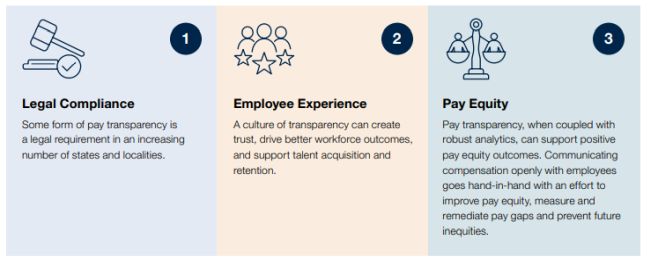Pay transparency is a reality in several states with nation wide implications, and many organizations are not ready. A number of states and localities have enacted legislation, and employees are increasingly applying pressure on their employers for greater visibility into pay ranges, structures and the rationale used for compensation decisions.
Implementing pay transparency entails more than the mechanics of disclosing pay information. Consideration of strategic matters, such as the impact on culture, retention, employee experience and the ability to attract top talent is critical. We believe that employers who embrace transparency with the above considerations in mind will boost engagement and retention, while competing more effectively for talent.
Dispelling the Misconceptions
Pay transparency represents the degree to which employers are open about how employees are compensated, and why they are compensated in the manner that they are. It doesn't necessarily mean revealing what each employee is paid, but it is about establishing and communicating pay practices that help employees understand how their compensation is set in the context of market and business realities.
There is no one-size-fits-all approach to pay transparency. The concept can extend beyond base pay to include variable pay and other rewards components (i.e., promotion, recognition, development and performance management). It's up to each employer to define how transparent they want to be given their industry, the geography in which they operate, and what's appropriate for their culture. The goal is to give workers an understanding of why they're paid what they are and what they need to do to progress within the company's pay structure.
Finally, increasing pay transparency could present an opportunity for companies. Compensation data may already be widely available through social media and crowd-sourced internet sites like Glassdoor and Salary.com. As a result, current and potential employees are already making salary comparisons, without the benefit of validated, accurate data.
Key Benefits
Pay transparency has shown benefits in building employee confidence in the fairness of both the compensation approach and process. The business case for pay transparency has three components:

Recent Developments
While pay transparency laws are not ubiquitous nationwide, a handful of states and locales, including New York City, thus far, have laws related to pay transparency either on the books or soon to go into effect. Many experts believe the issue will quickly gain more traction and continue to extend to additional jurisdictions. States are passing laws with varying requirements, creating additional complexity for companies operating in multiple states. The laws differ in their scope based on the number of employees, amount of compensation information to be provided (base salary or greater detail), types of job postings required (external and internal recruits) and data retention requirements. Starting in 2023, when pay transparency laws go into effect in Washington and California, approximately 20 percent of all U.S. workers will be covered under pay transparency laws. Some of the laws are outlined below:
NYC
New York City's pay transparency law went into effect on November 1, 20221 and requires salary transparency in external job postings. This means NYC employers with four or more employees must include minimum and maximum salary or hourly wage ranges on most job postings, including external job postings published or promoted by third parties. Other forms of compensation are not required to be disclosed. It also requires a greater degree of transparency for transfers and promotions.
Colorado
Pay transparency in Colorado became a requirement in January 2021 with the passing of a pay transparency law: Equal Pay for Equal Work Act2 . It applies to any job performed in Colorado and has been interpreted to apply to remote workers who may reasonably perform work in Colorado, even if the posting indicates that Colorado employees need not apply. The Equal Pay for Equal Work Act requires salary transparency in external job postings (i.e., figure or range of hourly wage or salary; a general description of all bonuses or other forms of compensation; and a description of employment benefits being offered for the position). The law also requires pay transparency for transfers and promotions—meaning, employers are to make known all opportunities for promotion to current employees. It also prohibits employers from asking for historical salary to inform employment or salary determinations. As part of this transparency movement, the law also requires employers to maintain records of job titles and wage history during each employee's employment term plus two years after separation from service.
California
California's pay transparency law will go into effect on January 1, 2023. It requires a salary / pay range in external postings for employers with 15 or more employees regardless of if posted by the employer or by third parties. The law also requires employers to maintain records of job titles and wage history during each employee's tenure plus three years after separation from service. This law also includes a requirement for private employers with over 100 employees to create and file an annual pay data report for the California Civil Rights Department, focusing on 1) the number of employees by race, ethnicity and sex, 2) the number of employees by these demographics whose annual earnings fall within the U.S. Bureau of Labor Statistics pay bands, 3) the average and median hourly wage for each combination of race, ethnicity and sex for the job categories, and 4) summaries of earnings for all employees in each job category by race, ethnicity and sex during a chosen pay period and for the entire reporting year. If an employer has several establishments that meet these qualifications, a pay report must be submitted for each establishment.
Washington
Washington state has a new pay transparency law going into effect on January 1, 20233 . The law states that employers with 15 or more employees will be required to include a pay range for any job posting and a general description of all benefits and other forms of compensation to be offered to hired applicants. This applies to postings published electronically, in hard copies, and by third parties. The law also requires that employers provide pay ranges for current employees' new positions when transferred or promoted internally.
Challenges
Adopting a pay transparency strategy and the programs, policies and procedures to support it is a significant undertaking, and deploying a change management and communication plan that prepares and trains leaders is critical to ensure an effective implementation. The better an organization prepares, the more effective the rollout and mitigation of risks. Pay transparency presents both operational and cultural challenges.
Operational challenge examples include:
Inconsistent adherence to pay ranges
Developing a pay philosophy with an agreed upon pay structure design takes time and resources. With the additional pressure of communicating pay to employees and prospects, it's important to develop a comprehensive pay structure that is utilized consistently and provides insights into the rationale for pay differences.
Insufficient communications
Preparation for managers to communicate pay transparently is crucial in managing and mitigating the risk of employee confusion or frustration. Research from WorldatWork indicates that 61 percent of managers are not trained to effectively communicate pay information to their employees.4 Educating managers and employees on pay structure design, total compensation, performance and how they are interrelated allows companies to manage the compensation narrative.
Poorly-defined compensation philosophies
Publishing salary ranges will naturally lead to questions about salary range development. Before creating and releasing salary ranges, a job architecture and leveling framework is critical to both the market benchmarking process and the organization's ability to explain how the expectations and responsibilities for a role equate to a job level and salary range. Together, job levels and salary ranges can show employees how their career and compensation can progress.
Cultural challenge examples include:
Pay equity concerns
Employees and job seekers are focused on pay equity practices and expect employers to provide details on their pay design approach and pay equity program. Employees will look for companies to consistently assess their pay equity status and close disparity gaps proactively. While this practice is built into many large companies, we recommend working with legal, finance, HR and DEI teams to implement a recurring comprehensive pay audit to investigate the existence of any gender-based or other compensation disparities. By addressing pay equity proactively, organizations can build employee loyalty and confidence in how compensation practices are performed, promote a positive brand and avoid legal actions.
Inconsistent sharing of salary information
As states have developed different requirements in providing job applicants the right to more information about pay, organizations may find that current employees grow frustrated by the absence of such information. To avoid situations where existing employees learn about pay range information from external applicants, it may be beneficial for organizations to strategically develop a pay transparency approach that goes beyond just meeting the minimum legal requirements in the state and meets the expectations of current employees.
Employee comparison, jealousy and division
It's valid to be concerned about employee pushback. While the ultimate goal is pay equity and enhanced employee performance, pay transparency may result in workplace tension, employee envy, and decreased morale and retention. Strategies to mitigate these risks include strong performance management programs that clearly outline expectations and outcomes and a clear pay philosophy to compensationrelated decisions.
Key Considerations
Understand intention
Before jumping into the how, it's important to think about the why. Understanding what an organization wants to achieve through pay transparency is an important first step. The strategy and planning for pay transparency will look different for a program motivated purely by compliance versus one that aims to leverage transparency and an enabler for employee positivity and engagement, talent acquisition or customer brand.
Map the transparency journey
Review the current state of the company's pay philosophy (if it exists) including, job architecture, descriptions and definitions, pay strategy, pay equity, employee pay sentiment and key compensation processes such as promotions, merit increases and bonuses.
Define the pay philosophy:
- For pay transparency to be successful, there should be a
consistent pay philosophy followed to develop, administer and
communicate compensation information.
- Work alongside leaders to build buy-in for embarking on a refreshed pay transparency journey.
- Determine where the company currently falls on the Pay Transparency Maturity Curve (see below) and where it wants to be
Pay Transparency Maturity Curve
- Compensation information is openly shared – there are no secrets
- Employees and managers are comfortable discussing compensation, performance, and how to advance
- Career paths are well-defined and communicated
- Visibility is provided for pay grades and ranges for all positions
- Compensation related discussions are open and occur frequently throughout the year
- Formalized compensation framework and structure(s) are in place
- Employees are informed of their salary ranges and where they fall within the range
- Managers are trained and capable of conducting conversations related to pay
- Foundational compensation frame and structure exist
- Communication system and processes exist for sharing basic compensation information
- Annual discussions of pay are conducted
- No formalized framework or structure exists for pay systems and transparency
- Limited communications regarding pay, pay philosophy, pay processes
- Employees informed of pay during annual cycles
- Design the organization's pay philosophy in alignment with the organization's talent strategy, performance management and culture. Updating the organization's market benchmarks annually will help ensure that its compensation structures are positioned competitively
- Identify (and close) gaps.
- With input from a pay audit and equity study, review the current approach against the newly designed pay philosophy. Identify impacted employees, managers and jobs.
- Prepare for the rollout to candidates and internal employees with thoughtful processes, policies, technology and data management.
- Implement the pay transparency strategy.
- Build a thoughtful change management strategy, including training leaders and managers.
- Manage feedback and continuously improve.
- Actively seek feedback and be open to areas of improvement. Assess the impact of pay transparency on employee and candidate sentiment and keep a pulse on what competitors are doing.
Begin the Journey to Pay Transparency
Pay transparency goes beyond sharing salary ranges, and with its complexity, it can be challenging to know where to start. A&M can help organizations navigate their pay transparency journey. Contact us today.
Footnotes
1. N.Y.C. Admin. Code § 8-107(32) (2022)
2. S.B. 19-085, 72nd Gen. Assemb., 1st Reg. Sess. (Colo. 2019)
3. 3.S.B. 5761, 67th Leg., 2022 Reg. Sess. (Wash. 2022)
4. Survey-Brief-Pay-Transparency-Survey-Jan.-2020.pdf (worldatwork.org)
The content of this article is intended to provide a general guide to the subject matter. Specialist advice should be sought about your specific circumstances.





